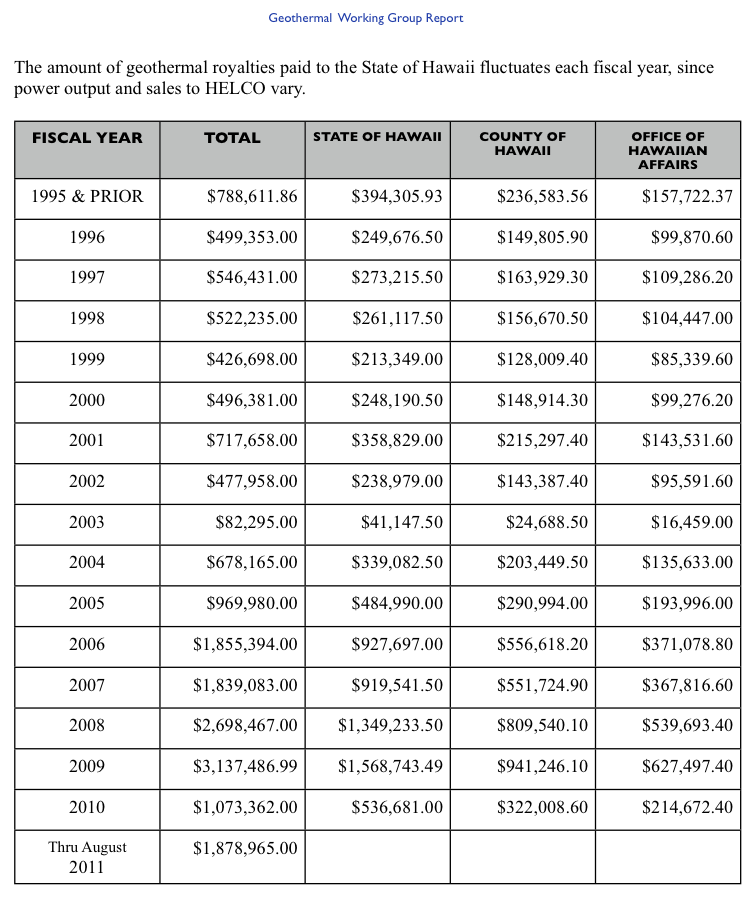Advantages of geothermal:
- It is an indigenous resource
- It generates revenue for the state
- It generates community benefits
- It provides stable power
- It is less than half the cost of any of the renewable energy alternatives.
- The Big Island will be over the geothermal “hot spot” for 500,000 to 1 million years
I want to share some highlights of the Geothermal Working Group’s final report.
Page 10, Revenues derives from geothermal:
Page 12:
IV. Recommended Steps for Hawaii State Legislators
– Make the allocation of geothermal royalties more transparent to show how benefits come back to the community. Designate the records of the allocations to be public domain.
– Establish a community advisory board to offer suggestions to the DLNR about how royalties generated by geothermal power plants are spent. The advisory board should be members of the communities that host existing or future geothermal power plants and/or those who are most impacted by the development of geothermal energy.
– Encourage the DLNR to use geothermal royalties to identify promising geothermal sites and to further develop the resource.
– In light of the probability that oil will reach $200 per barrel (Lloyds of London), the legislature is requested to commission a study to show the economic impact of various prices of oil.
– Facilitate development of geothermal with a critical review of the geothermal permitting process, regulatory capabilities, and possible investment incentives.
Page 5:
The Geothermal Working Group’s principal findings
– Geothermal is a renewable resource indigenous to the island of Hawaii that is dissociated from the price volatility of petroleum fuels.
– Geothermal can be a key component in a diversified energy portfolio for Hawaii County, both for the electrical grid and for transportation.
– In Hawaii, geothermal is a firm-energy resource at lower cost than fossil fuel. – Developing multiple geothermal plants is the most prudent approach.
– Geothermal has the potential to supply baseload electricity; long term reliability and the ability to supply grid management services (currently supplied by conventional fossil-fueled power plants) must be demonstrated in order to consider geothermal as the primary energy resource.
– With geothermal power plants, agricultural fertilizers, hydrogen, oxygen, and business-enterprise power can be produced for off-peak rates during the hours of curtailed electrical demand.
Page 9:
Overview
Geothermal energy can be developed to become the cheapest form of baseload power for Hawaii County. There are no importation or storage costs. Using geothermal as the primary source of baseload power will permit the county’s businesses to be more competitive with the rest of the world. Using geothermal as the primary source of baseload power will also help folks on the lowest rungs of the economic ladder—those who struggle with the cost of services.
In addition to stability and affordability, geothermal can leave less of an environmental impact than the commercially-available baseload power sources of electricity. There are no greenhouse gases, emissions and no oil spill risks.
The lower rates of off-peak geothermal electricity encourage the production of ammonia locally. Ammonia is an efficient hydrogen carrier that can be used to power internal combustion engines and as an aid to local agriculture as fertilizer. Light-industry business parks constructed near geothermal energy plants can use excess heat as a resource for heating vegetable and tropical flower hothouses, drying wood, and drying fish.
Benefits of geothermal energy to the community include sharing in geothermal royalties. In accordance with state law, the geothermal royalties are paid directly to the Department of Land and Natural Resources who allocate the royalties in three ways:
1. Department of Land and Natural Resources receives 50% 2. County of Hawaii receives 30% 3. Office of Hawaiian Affairs (OHA) receives 20%
Potential adverse impacts are listed below:
– Interference with worship of the Goddess Pele – Interference with certain Native Hawaiian practices – Rainforest destruction – Possible health and safety impacts – Disruption of the way of life for nearby residents – Hydrogen sulfide and other air quality issues – Noise – Increased strain on an inadequate infrastructure – Impact on native fauna and flora

